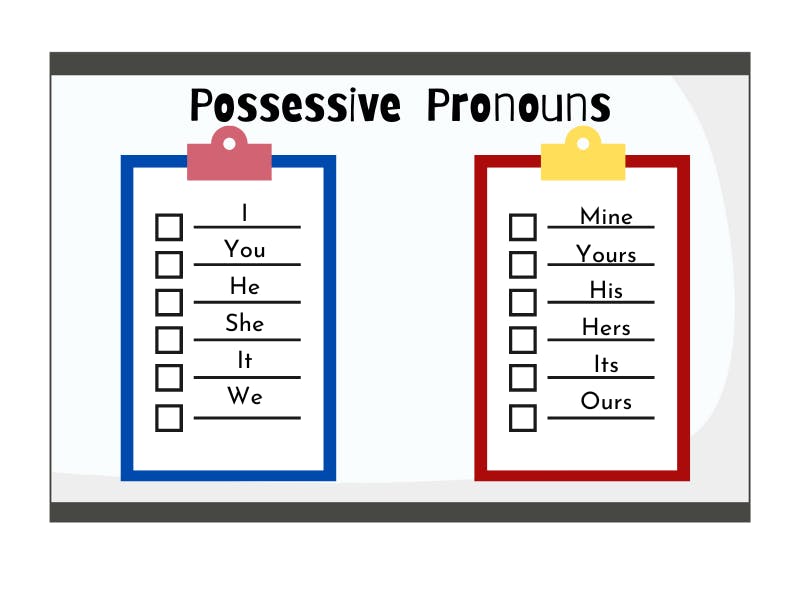Your Handy Guide to Possessive Pronoun Examples and Uses
ELA and ESL alligned to Common Core CCSS.L.1.1, CCSS.L.2.1, and CCSS.L.3.1.
More content
Want to learn about possessive pronouns? Here we've got possessive pronoun examples for teachers to save time on lesson planning. This guide would be appropriate for early elementary students, and we want to keep the language smooth and easy to understand for the benefit of any ESL students in this age range, too. There are also flashcards and quizzes, for students to practice possessive pronouns and demonstrate their understanding and command of standard English spelling and grammar as per the Common Core Standards.
What Makes a Pronoun Possessive?
As you might guess from the name, a possessive pronoun shows some form of ownership. In almost all cases, examples of possessive pronouns will show how a person, animal, or thing can own a thing or idea.
What are possessive pronouns in English?
The possessive pronouns in English are:
- Mine, yours, his, hers, theirs, ours, and its.
Possessive pronouns can replace nouns to show ownership so we don't repeat ourselves. They show what belongs to who.
Examples of possessive pronouns
- That red shirt is hers (she owns the shirt)
- This water bottle is his. (he owns the water bottle)
- Yours is over there. (something that belongs to you)
- That's theirs. Put it back! (something belongs to them.)
- Can I borrow your pen? No, sorry, it's not mine. (mine replaces pen)
Possessive Pronoun Flashcards
See if you can complete the following sentences with the correct possessive pronoun. Flip the flashcard and discover the answer!
Examples of Possessive Pronouns
The pronouns in the possessive form that you can use alone include whose, theirs, ours, his, hers, mine, and yours. You will notice that his and hers still show up here. You can use these two possessives by themselves or with a noun directly. If you do use any of the above pronouns alone, you will see that they can do any job that a regular noun can do. They can become different parts of a sentence, including the direct object, the object of a preposition, or the subject of the sentence. Let’s take a look at a few examples to illustrate this point.
- Yours are the best ideas.
- They found our book, but our friend didn’t find theirs.
- The place is full, but they can stay at ours.
- You have a big bag of candy over there. It's yours.
How Else do Possessives Function?
We’ve gone through the basic ways to recognize and use possessives here, but they can change their functions, too. One way they do this is by being both interrogative and possessive at once. We normally use interrogatives to ask questions, and we can combine them with possessives in order to form questions about unknown things or how much of something there is.
1. Whose books are these? (whose is a pronoun in the possessive that is also pulling duty as an interrogative pronoun)
2. Whose team won?
3. Whose toys are these?
Possessive Pronouns Quiz
Got it? Why not try this possessive pronouns quiz with your students?
1. Tommy forgot _____ bag.
Choose the best answer from the choices below
2. I got a new storybook for my birthday, my mom said it's _______.
Choose the best answer from the choices below
3. Please don't touch the wet paintings, they are _______. (we)
Choose the best answer from the choices below
4. Those bikes are ________. (they)
Choose the best answer from the choices below
There are tons of types of pronouns in English! Including personal, demonstrative, indefinite, relative, reflexive, or intensive pronouns, just to name a few. Remember that pronouns that take the possessive form are all about ownership and can show a clear ownership or belonging between objects and owners.
